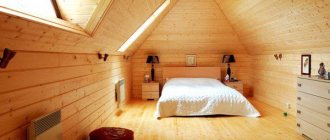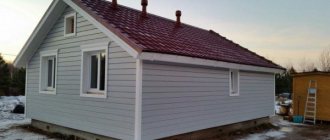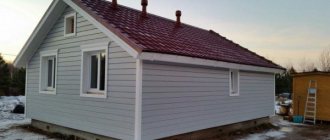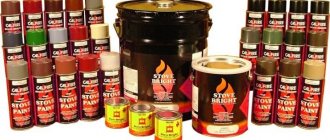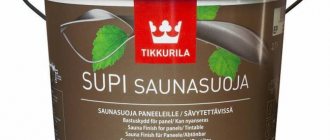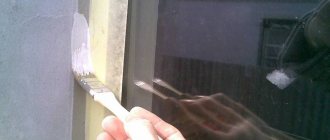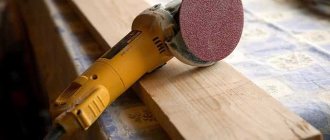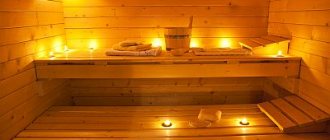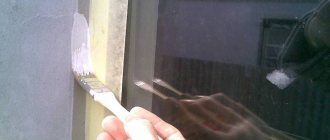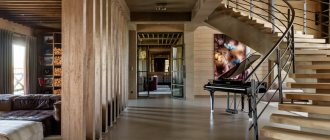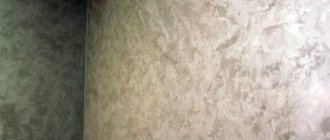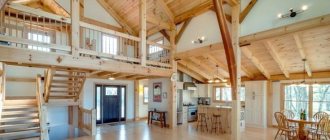Among the well-known methods of decorative finishing of facades and interiors of a modern country house, the option of cladding it under timber (imitation timber) stands out. The indisputable advantage of this approach is the possibility of saving on expensive natural materials while maintaining the decorative appeal of the structure being built.
However, before choosing this option for finishing a house, you should carefully familiarize yourself with the features of the procedures that allow you to give the coating material the required color shade.
In our article we will tell you about how to coat imitation timber in order to give it the appropriate shade, and also introduce you to some of the subtleties of these operations.
Indoor painting
The atmosphere inside the house directly depends on how the painting is done. You can achieve the desired result and make the room more comfortable by original painting of the walls to match the timber. The advantage of lumber is that it retains its decorative properties well and for a long time. Toning imitation timber with paints, varnish or oil is carried out in several stages. Each is worth considering in detail.
Surface preparation
Before you start painting the walls, you need to pre-treat the surface
To do this, you should take into account the following recommendations
You will need to remove a small layer of material first to prevent the paint or varnish from peeling off later. This is done using sandpaper or by grinding. The next step is to thoroughly clean the surface from dust, burrs and other types of wood deformation. To do this, it is recommended to use a damp cloth or vacuum cleaner. If you plan to treat a wooden surface with opaque compounds, you can use a stiff brush to make small indentations in the material. They will help emphasize its naturalness. After completing previous work, it is worth thinking about protecting the surface. This is done by applying antiseptics and special impregnations to it, which prevent the process of rotting and extend the life of the product.
It is especially important to take this point into account for rooms with high humidity levels. If desired, you can additionally prime the surface to improve the adhesive properties of the material.
When the impregnation with primer compounds is completed, all that remains is to wait until the wood dries and you can begin painting work.
Applying paint
Experts recommend painting wood in two or three layers.
The work should be performed in this sequence.
- First of all, after preparing the surface, it is necessary to dilute the coloring composition in a large container. It is recommended to dilute the paint taking into account the required proportions in order to achieve the desired color and consistency.
- Once the paint is mixed, care should be taken to select the appropriate tools. The composition can be applied with a brush, roller or special equipment - a spray gun.
- The third stage is the application of the coloring composition. It is worth starting work from the ceiling, gradually lowering. If you have chosen a brush for painting, it is not recommended to completely dip it into the container. This will help avoid leaks.
- The paint should be applied to the surface in a thin layer, and during the application of the composition it is necessary to monitor the uniformity of the coating and paint over even the most inaccessible areas.
- When the first layer has dried, you can apply the second. The drying time of the composition can be read on the packaging.
The application of the second and subsequent layers is carried out taking into account the same requirements and recommendations that were specified in the scheme.
Varnish coating
The standard application of varnish to the surface of wood is no different from the method of applying paint. First, treat the surface with an antiseptic, then cover the surface with a varnish composition. However, if you wish, you can use another option for applying varnish, which will help make the decor of the timber more original.
Apply a base coat of varnish
Particular attention should be paid to the recesses in the wood surface. Remove a couple of millimeters after the first layer has dried. This is done using sandpaper or another suitable tool.
There is no need to touch the recesses; the varnish should remain in them. Clean the surface from dust formed after sanding. Apply a second coat of varnish.
When the composition dries, the texture of the wooden surface will become distinct and bright.
Natural flaxseed oil
This is one of the safest coatings for human health, which has long been used for treating wooden surfaces. Other advantages of the product include environmental friendliness and antiseptic protection. Linseed oil does not hide, but rather emphasizes the texture of the fake timber.
But the product also has disadvantages:
- long drying time
-
up to 3 days for one layer; - the number of layers should be at least 5–7;
- poor polymerization;
- darkening when exposed to direct sunlight.
Linseed oil is most suitable for interior decoration on structural elements that are not subject to abrasion - for example, on ceilings. This type of coating is especially suitable for valuable wood species, since it preserves its properties to the maximum.
The most effective means for treating the outside of your home
"Senezh". The domestic manufacturer produces tinting and preservative antiseptics based on acrylate and water, bleaches and fire-retardant compounds. Under the Senezh brand, more than twenty types of hard-to-rinse products are produced for treating the facade and bottom of a log house, providing protection for wood for more than ten years.
"Belinka". This brand offers a wide range of protective products that protect wood from moisture, insects, UV radiation and fire.
"Pinotex". Polymer-based products are perfect for internal and external processing of timber, including imitation timber. The products are resistant to large temperature changes and protect the simulated timber from moisture, fungus, and microorganisms.
"Neomid". Antiseptics for external use, protecting wood from biological damage for 6-7 years. The manufacturer also produces fire retardant compounds, wax impregnations, bath oil, and special products for processing ends.
"Tikkurila". The Finnish company produces moisture-resistant preparations that create a protective film on the surface. External wooden surfaces treated with these compounds receive good protection from various atmospheric conditions.
"Aquatex". Inexpensive primers and impregnations made in Russia protect the outer walls of the log house from fungus, moisture and ultraviolet radiation. Available in clear and tinted forms, there are fifteen options in different colors on the market.
carries out all types of work on the territory of Moscow and the Moscow region for finishing a wooden house. The processing of the façade of the log house is carried out by our craftsmen strictly according to technology, taking into account the peculiarities of the structure. All materials we use have the necessary certificates.
You can ask questions, send your application and call a specialist to draw up an estimate using the coordinates located in the “Contacts” section.
If you need help, we can recommend you the Help Consulting company. These are our partners with whom we have been working for several years and trust them to resolve all legal issues.
Calculate the cost of painting and insulating your home right now
Do you have accurate measurements of the house?
I measured it myself. I have a house design. Measurers came. I want to call a measurer.
By clicking on the button, you consent to the processing of personal data
Review of the technology for installing PVC windows in houses made of wooden building materials
How to properly insulate the floor from below - rules and nuances
Overview of the characteristics and features of Titan sealants
How can a shareholder protect his rights?
Impregnations
Wood is a capricious material. It is susceptible to attacks by pests, microorganisms, and fungi. It is also a flammable material. To protect the finish from threatening factors, various protective impregnations are used:
- antiseptics
-
effective against fungi, bugs, rotting; - flame retardants
-
prevent ignition or rapid spread of fire; - biopyrenes
are
combined preparations that reduce the fire hazard of a material and also protect against insects, mold, and mildew.
Many of them perform not only a preventive function, but also have coloring properties. After such a product, you can use a topcoat.
Attention!
Manufacturers often supply the market with finishing timber that has been treated with similar substances at the factory. This information is usually indicated on the packaging.
Prices for glaze impregnation for wood
Glaze impregnation for wood
Video - Wood treatment with impregnations
Indoor paint application technology
The number of layers required for interior painting of wood inside a house is two or three. If staining is carried out in only one layer, then after a year you will have to repeat the entire staining procedure again.
The dyeing process is as follows (photo below):
- the first thing to do after preparing the surface is to dilute the coloring composition in a clean and sufficiently large container;
- this must be done in compliance with all specified proportions in order to obtain the desired color (using tinting) and consistency;
- after that, having chosen a tool for painting (it can be a brush, roller or spray gun), they begin to apply paint to the surface of the imitation timber (you should start from the ceiling);
- It is best that if you choose a brush for work, do not dip it entirely into the composition and do not pick up a large amount of the composition at one time. This will lead to unevenness of the layer and drips, which are quite difficult to eliminate afterwards;
- The paint is applied to the surface in as thin a layer as possible. During the process, you should control the uniformity of the surface coverage, carefully paint over everything, even hard-to-reach areas;
- after the first layer has completely dried (the drying time for each composition is individual, indicated on the packaging), you can begin the second stage of painting;
- The second layer is applied in the same way.
Aqualak
The difference between this type of coating and the others is the hard protective film,
which protects the material from moisture penetration. But, unlike other types of varnishes, this product is water-based and contains acrylic. Therefore, the product is often used for interior work, since it does not emit an unpleasant odor. Clean water is used for dilution.
The product may contain a coloring pigment, giving the base even more attractive. In this case, the wood texture is visible through the coating. At the same time, the coating protects the material from rotting, fungi, and mold. The paint dries quickly, so several layers can be applied within 24 hours.
One of the few disadvantages is the high speed of work.
If painting is carried out slowly, spots may appear due to uneven application of the coating.
The following manufacturers of paints and varnishes have such products
- Rolax;
- Tricolor;
- "Rogneda" and others.
Features of painting procedures
Regardless of the option you choose to protect the lining, first of all you should worry about the quality preparation of its surface for applying the decorative composition. For this purpose, the front side of the material must be primed, which significantly increases the reliability and durability of the coating being installed. Let us consider each of the above methods of its formation in more detail.
Application of conventional paints
To paint the imitation timber look, any of the known dyes (alkyd, acrylic, oil) can be used, the selection of which must take into account their drying time. For any of the above dye options, the sequence of painting operations is as follows:
- first, the front surface of the lining is cleaned with a wire brush and then thoroughly sanded;
- upon completion of grinding and removal of dust residues, it is impregnated with an antiseptic (for these purposes it is recommended to use transparent compounds that do not affect the shade of the dye applied on top);
- A layer of primer is applied over the antiseptic, the type of which is selected based on the brand of dye used. So, in the case of using oil paint, for example, drying oil is chosen as a primer;
Stages of painting imitation timber
When performing painting operations, it is advisable to adhere to the following recommendations:
- Do not paint in very hot weather, or when the air humidity in the room is high;
- painting should be done in two layers (provided the previous one is completely dry)
Coating with transparent compounds
These compounds include various antiseptics, usually sold under the brands Pinotex, Tikkurila, etc.
After being applied to the surface of the lining, these compounds penetrate deeply into the material, not only protecting it from destruction, but also perfectly revealing the structure of the wood. Among other things, these coatings are environmentally friendly and do not require mandatory ventilation of the premises.
Various types of oils can also be used as transparent coatings. Some of them (the so-called “Danish” composition, in particular, made from boiled linseed oil, varnish and white spirit) after penetrating the wood, they immediately polymerize in it and form a reliable protective layer.
To obtain an environmentally friendly protective composition, you can also use natural ingredients such as gum turpentine, rosin and linseed oil.
All of the natural compositions listed above, in addition to their decorative and protective functions, create a reliable vapor barrier that prevents the penetration of moisture into the finishing material.
Textured painting
Textured painting owes its popularity to the fact that the usual, monochromatic coating of opaque dyes is not particularly attractive or original.
To increase the attractiveness of the manufactured decorative and protective coating, the following simplest methods of forming its texture are used:
Formation of a relief pattern on the surface of the material using a regular metal brush, which is carried several times along the fibers. As a result of this operation, soft fibers are removed, while hard fibers remain unaffected.
Upon completion of this procedure, the surface is cleaned with a soft brush, and then a layer of glaze is applied to it. After removing excess coating with a sponge, the surface is additionally coated with transparent varnish.
By obtaining the effect of “bleached” wood, achieved in the same way as in the previous case, but using white glaze applied over transparent varnish with obligatory blotting with a sponge. As a result of this operation, the spaces between the hard fibers become white, while the protruding parts of the fibers retain their natural shade;
Stain (stain)
This product penetrates deeply into the wood structure, thereby emphasizing its pattern. Unlike drying oil, it does not form a film, so the pores of the natural material remain open. Therefore, the surface at the second stage is usually coated with varnishes. There are two types of stains - water-based and organic. These products are available in liquid or powder form. The disadvantage of stain is that it does not hide surface defects. At the same time, it allows you to even out the color of the wood.
Prices for different types of stains
Do I need an antiseptic?
There is no doubt that wooden cladding with imitation timber used outdoors needs protection from biological damage. On the façade there is always an increased danger of the material becoming wet, and this is the first step to the appearance of mold, rot, fungi, algae, mosses... After all, water is a breeding ground for pests of all types. And wood-boring insects on the street have a greater chance of settling into our false wall.
It should be noted that similar protection will also be required in the case of wall cladding in rooms with high humidity.
The question remains: is it worth impregnating the walls with an antiseptic after installing the imitation timber, or is it better to treat the material before fixing it in place, when it is possible to protect:
- The front surface
- Castle elements,
- The back surface
- The ends (in fact, this is the most vulnerable part),
- Wooden frame made from edged timber.
Treating wooden cladding with an antiseptic In the provisions of the currently valid GOST 8242-88, we are told that not all profiled parts made of solid wood are subject to mandatory antiseptic treatment. Bioprotection requires treating the back surface of only the window sill board and only the floor board. And where protective and decorative treatment is present, biosecurity is not required according to this standard.
In principle, you can limit yourself to following just such instructions, especially when it comes to cladding walls inside a building. However, it is still better to treat the façade material with some kind of non-washable compound. For example, you can use antiseptic "Nortex"-Lux. And if suddenly wooden surfaces already have some traces of infection, then it makes sense to treat them with a “treating” agent, for example, “Nortex”-Doctor.
What characteristics of painting materials should you pay attention to?
- Possibility to use outdoors.
- Can be used indoors (environmentally safe).
- How it holds high temperatures (relevant for steam rooms).
- Does it provide protection against fire and biological damage?
- What materials does it combine with?
- How many layers should be applied?
- How long does it take to renew the coating?
- What kind of materials is the product designed to process (permissible moisture content of the lumber, is there any damage or is our surface completely healthy...).
- Does it form a film (glossy, matte surface...).
- Does the level of vapor permeability of wood change?
- Is there a coloring effect, can it be tinted?
- How long does it take for the layer to dry, at what temperatures can it be applied.
- What application methods are acceptable?
How to paint wood correctly
When performing painting work, it is important to fulfill certain requirements. In this case, the coating will be of high quality and durable.
The old surface is first cleaned of old coatings and cleaned with sandpaper, and then the dust is thoroughly removed.
Before applying the decorative coating, the surfaces are treated with fire retardants and antiseptics, which protect the surface of the false beam from fungus and mold. If mold has already formed, bleach is used first.
When using several products at the same time - for example, stain and varnish, you need to make sure that they are compatible. Otherwise the finish will be damaged. You also need to wait until the previous layer dries.
Before applying paint and varnish material, it is better to use primers. Typically, the manufacturer specifies this requirement in the instructions for the paintwork, and also makes recommendations as to which product is best suited. This not only improves adhesion to the surface of the timber, but also reduces material consumption.
Painting is carried out at an air temperature of at least 5 °C.
If work is carried out outdoors, there should be no precipitation. The surface of the false beam must be dry.
Video - How to paint wood with high quality
Painting imitation timber is easy even for a beginner. The main thing is to use the chosen coating correctly.
So, how painted imitation timber is produced, how to order painting of panels, and what the cost of painting imitation timber will be, we will tell you in this article.
Often, painting imitation timber indoors is done after installation. This is fundamentally wrong. Let's look at this example:
installation of panels, area approximately 100 m2, imitation material, execution - team of carpenters. So, the installation was completed in a short time, well done guys, they did their best.
It's decided. The guys are handy and will paint it themselves. Next comes the customer’s choice of paint and painting of the imitation timber inside the house begins...
Rest assured, you will not be satisfied with the quality of the surface being painted. And why?
- It is very difficult to pre-sand the wall;
- If sanding is done, the appearance of the coating will still not be ideal. It is IMPOSSIBLE to sand the chamfered areas on the wall; painting imitation timber in these places will raise the wood pile and this will significantly damage the visual effect;
- the same can be said about intermediate sanding; it is technically impossible to do it efficiently on a wall;
- the product, after a short period of time (for example, after turning on the heating) will slightly change its geometry, this is a natural process, even for a painted imitation of timber, and at the joints the color of the wood will be visible, which could not have been covered by a coating layer.
So, knowing these BUTs, it is better to make a choice in the direction of painting imitation timber in the workshop of a company specializing in this. Moreover, buying a finished product with delivery may be even cheaper than having workers perform the same operations at your facility. This purchase will please you with its high quality:
- preliminary grinding, including chamfer grinding;
- applying adhesive primer;
- intermediate grinding;
- applying the required thickness of paintwork materials in microdistricts.
The price of painting imitation timber for installation outside the house will be more expensive than for work carried out indoors. The cost varies due to the fact that to protect the façade from an aggressive environment, it is necessary to use more expensive coatings with a large dry residue.
All photos from the article
Nowadays, there are many options for exterior home decoration. People who like to feel closer to nature often choose imitation timber for cladding their home, both outside and inside. Externally, such a house will not differ from a completely wooden one, but painting imitation timber indoors and outdoors has a number of features.
Waxes
Wax paints are another product that is widely used for decorating wooden panels, including false beams. They are made from natural wax or its artificial substitutes based on petroleum products - paraffin, ceresin.
Wax paints are applied to the surface without a primer. Use a brush or cloth for this. Usually two treatments are required to achieve the required coating thickness.
When using wax paints, a pronounced film does not form on the coating. The surface turns out matte, the difference from “bare” wood is sometimes almost invisible. Wax-paints are presented for both interior and exterior use. They may contain a color that radically changes the color of the finishing material.
Advantages of wax paints:
- formation of a thin protective layer;
- closing wood pores;
- silky, matte shine;
- protection from dirt and moisture;
- antistatic effect;
- possibility of restoration of worn parts.
Reference.
To emphasize the structure of the wood and make it more expressive, some manufacturers recommend using oils as a finishing coat.
Popular products in this category:
- Tikkurila Nostalgia;
- Adler Legno-Wachs;
- Watco satin wax and others.
How to make wax with your own hands - step-by-step instructions
You can prepare such a coating for wood at home. To do this you will need:
- beeswax or carnauba wax - 1 part;
- linseed oil - 1 part;
- rosin - 5% of the total mass.
Sequencing:
Step 1.
Grind the wax and rosin.
Step 2.
Place the wax in a water bath and wait until the substance melts.
Step 3.
Add vegetable oil and rosin to the container without removing from heat.
Step 4.
Mix until smooth.
The finished mixture is poured into a convenient container. If the product is not used immediately, then place it in a dark place and store no longer than 6 months.
Reference.
The more oil in the composition, the more liquid the coating. Coloring pigments can be added to the composition.
Fastening imitation timber with what and how
There are several ways to attach imitation timber, which differ in both labor intensity and cost, as well as the aesthetics of the result. The simplest solutions involve fastening with nails from the front of the board. More complex and interesting options include installation in a groove, tenon or in the front part, made “hidden”, when the fasteners are invisible. In some cases, you can use so-called clamps to fasten imitation timber.
Fastening imitation timber with nails
The cheapest and easiest way is to nail the imitation from the front part with ordinary construction nails: one fastener to each sheathing bar. Nails must be galvanized, and their length must be at least the thickness of the finish + ? thickness of the sheathing bar. The solution is unaesthetic (the hats are conspicuous) and will not allow you to fully achieve the effect of simulating timber.
You can use finishing nails (also galvanized). They are distinguished from construction nails by their miniature heads, which are completely embedded in the wood during installation. Such fasteners are driven into the tenon or groove of the board at an angle of 45 degrees. Screw nails are also suitable for these purposes, which guarantee protection of fasteners from extrusion during the process of changing the linear dimensions of materials.
Fasteners for simulating timber - self-tapping screws and self-tapping screws
For high-quality installation of the imitation, it is recommended to use galvanized universal screws and self-tapping screws that provide hidden fastening. Fastening is carried out in a tenon at an angle of 45 degrees or in the front part with preliminary drilling of holes for plugs. After fastening with screws or self-tapping screws, the latter are covered with glue, sealed with wooden plugs and sanded.
An alternative solution is to use so-called Spax screws or fasteners for solid floors. You can read about their advantages on the sellers' websites. Let us only note that they are more expensive than ordinary self-tapping screws, but it is worth it if imitation extra timber is used for finishing.
Clamps for installing imitation timber
For interior work, you can use so-called clamps to fasten imitation timber. They are stamped steel products that are mounted on the sheathing. The finishing board is simply “hung” on the clamps. Manufacturers position such fasteners as simple and reliable, but in reality it turns out that their use is expensive and not always ineffective - this is evidenced by reviews of imitation timber and recommendations from people who independently dealt with the issue of its installation.
Cost of installation of imitation timber
If you decide to entrust the installation of imitation timber to third-party workers, then it is worth considering that in this case the price for the work is usually the same as the price of the materials used. You can find approximate prices for individual stages of installation work in the table below.
It’s not news to anyone that the success of realizing the designer’s ideas depends on the quality of the finishing.
Imitation of timber
When it comes to decorating the inside of a home, the design solution may not be implemented correctly, causing the overall ambiance to be seriously affected.
Today, decorating a house in a rustic style, in which the room is simply overflowing with wood elements, is very popular today. In this design, a very important role is assigned to the imitation of timber, which can give the room a finished, laconic appearance.
Imitation of timber can be used for various reasons. Basically, it plays a decorative role, but it can also carry a completely functional load.
If the installation is done correctly, you will have the opportunity to zone the space, which will make your home even more unique. There is no point in doubting the long years of service of the structure.
Artificial timber is a high-quality, strong canvas that will not lose its attractive appearance during use for many years.
The main types of material are shown in the table.
If you decided to sheathe a room with timber and appreciated many of its positive qualities, you most likely wondered how to attach the imitation timber?
Acrylic coatings
Acrylic paints are actively used in European countries. They are also water based and dissolve in water. These are fairly durable coatings, which include:
- plasticizers
- give elasticity to the product and do not crack; - hardeners
- accelerate the process of film formation; - matting components
- eliminate glossy shine.
The advantages of such acrylic coatings include:
- environmental safety;
- no unpleasant odor;
- vapor permeability;
- resistance to burnout;
- rich color palette;
- protection from moisture.
The coating dries in 5–30 hours.
Acrylate paints are used for both external and internal work. Painting is carried out every 3–4 years.
This type of coatings is contained in the following brand lines:
- «Drevoplast";
- "Extra";
- "Yaroslavl colors";
- Pinotex ultra;
- Tikkurila Pika-Teho;
- Dufa.
Exterior paneling
It must be remembered that imitation timber is used for a ventilated facade and there must be a gap between the cladding and the thermal insulation layer. The panels can even be attached to objects made of logs or natural timber. This technology is convenient because it allows you to preserve the original appearance of the building for a long time. Therefore, it is profitable and rational.
Open plan in a country house
When purchasing material, you should consider the main nuances:
- Humidity level up to 15% (to prevent facade distortion during operation).
- Availability of grooves. The original appearance of the panels will remain longer.
- Width about 100 mm. The siding will look like timber. With a smaller width, the panels will look cheap, and wider ones will look sloppy.
- Quality of the locking connection.
- Smoothness, evenness, absence of damage and defects.
The material and components are preliminarily calculated, walls, window and door openings are measured.
Stylish kitchen
High-quality panels are not difficult to install. But the work is carried out in strict order:
- Prepare the surface by cleaning the walls from dirt. They can be treated with an antiseptic against pathogenic microflora.
- The sheathing is placed vertically to the base and secured with dowels or self-tapping screws.
- High-quality vapor and heat insulation is installed. The insulation is attached to a vapor barrier film and covered with it, the joints are taped.
- Panels with decorative elements are attached.
- The facade is secured with nails or screws.
- Cover with antiseptics and varnishes.
Rustic style
The panels need to be fastened in the direction from bottom to top, the grooves are located in the lower part. This will prevent moisture from entering. The first bar is placed with a level, since the evenness of the surface will depend on its correct installation. The fasteners are screwed in at a 45 degree angle.
Work is carried out at a temperature of at least -15°C, in dry weather. Panels should only be painted in dry and warm weather.
To extend the life of a façade covered with slats, you should properly care for the surface. It is necessary to periodically coat them with varnish and check for rot, fungus and defects.
Useful video
How to paint the outside of a house, technology on video:
The imitation timber arrived in time for the May holidays and was stored inside the house. We also purchased 5 liters of Teknol 1881 primer and 20 liters of Nordica Eco 3330 paint.
I decided to prime and paint the first layer of paint on the ground. To a certain extent, this is more convenient, and besides, you are not dependent on the vagaries of nature.
Thanks to the lack of partitions inside, the entire house turned into a huge paint booth. An unpainted imitation was stored against one wall; in the center there were trestles on which boards were laid for painting and then transferred to the other wall, where they were stored for final drying.
8-10 boards were painted in one “batch”.
Primer 1881 was tinted to match the paint color to make it easier to understand where the surface was already primed and where it was not yet.
The 1881 primer itself, according to Teknos instructions, was diluted with water in a 1:1 ratio. The sellers recommended not to dilute, for better coating quality, but in this case the soil would have to dry for a very long time and at a good summer air temperature of at least +20 degrees. And it's May outside.
After the primer had dried, the imitation timber was painted in the same way with Nordca Eco 3330 paint.
By the way, painting with paint is much easier than with primer. The entire imitation was painted in just 1.5 days, including smoke breaks.
The main painter was my wife, and I joined her only periodically.
In total, priming and painting took about 3.5 days of leisurely work by 1 person.
Surface preparation
To achieve a high-quality result that will last for many years, the surface of the imitation timber must be prepared; for this, use the following recommendations:
- It is better to start work when the temperature reaches + 5 degrees Celsius;
- to ensure improved adhesion of the paint composition to wood, it is sanded and sanded;
- Next, it is recommended to prime the surface and wait for it to dry completely.
NOTE! We should not forget about cleaning the surface, since dust particles accumulated after sanding and grinding interfere with the quality of the work. It is recommended to use a vacuum cleaner to remove dust.
At the surface preparation stage, you can use an iron brush and use it to treat the entire surface. This will ensure the deepest penetration of the composition into the wood material. In other words, this surface preparation technique is called brushing. It enhances the natural texture pattern, and the method is also suitable for giving wood an antique look.
Azure
Glaze is a coating that is increasingly used when working with wood materials. This is also a transparent material, leaving the texture of the false beam open to the eye. It is an analogue of varnish, but with less covering power.
Advantages of azures:
- allows the wood to breathe, so the moisture accumulated inside easily evaporates;
- the coating can be quickly and easily restored;
- Doesn't peel off like some paints.
Glazes are water-based and solvent-based, transparent or colored. Some manufacturers include biocides
- substances that prevent the formation of mold and mildew.
It is noteworthy that products without biocides better protect wood from dampness and ultraviolet radiation. However, in this case it is better to additionally use special antifungal impregnations.
Table 1. Types of glaze based on coating thickness.
| View | Coating thickness, microns | Place of application |
| Thin layer | Up to 20 microns | Does not form a film, but only nourishes. Place of application: plank sheathing, fences, and other elements subject to deformation. The coating needs frequent renewal to fully protect the wood from adverse conditions. |
| Medium layer | 20–60 µm | Suitable for elements with moderate deformation |
| Thick layer | From 60 microns | Does not penetrate deeply, but forms a film on the surface, reminiscent of a varnish coating. Used for doors, windows, and other structural elements that are not deformed |
Attention!
Glaze should not be used if the air temperature
is below 12 °C.
LMB selection
Every owner wants to make their home stylish and beautiful.
This also applies to houses that are made from imitation timber.
Today, the products that are used to paint such wood can be divided into two groups: colored and colorless.
Colorless
These are the so-called aqualacs, impregnations and glazes. Their big advantage is that they emphasize the structure of the wood and its natural shade.
And this means that the material will not rot. The most common option for painting is drying oil.
But it can darken over time, so after a certain amount of time it is removed and reapplied.
Colored
These are also very popular products for painting imitation timber.
This includes water-based and acrylic-based paints.
This also includes various enamels. This paintwork material has a color scheme under which the wood will not be visible.
This method is suitable if the overall interior does not require the structure of the wood and its natural color to be visible.
Such paints can be applied only after the surface has been covered with putty to prevent various defects, the color of which will not match the color of the base paint.
When working with colored materials, you need to thoroughly wash the base from other paintwork materials.
It is also better to walk over the surface with a solution of soda. And just before painting, you can cover it with another layer of drying oil, and only then with paint.
Painting imitation timber at the factory
A good option is to purchase one already painted, this saves personal time.
Also, this material has other advantages:
- Beautiful appearance;
- High level of durability;
- Protective layer from precipitation and sunlight;
- Convenient transportation and installation of this material.
Color selection
Painting imitation timber is characterized by coating the material with a composition that provides the wood with a certain color and aesthetic beauty. From this point of view, this stage is called the most important stage of finishing the building.
Before covering the imitation timber with a special mixture, it is advisable to study the available range. The domestic market offers a wide selection of products. Let's consider the key points when choosing a material:
- Colored dyes are intended for application to pre-primed wood. All compositions of the corresponding class can be used as a dye (for interior decoration).
- Invisible mixtures highlight the beauty of the wood while preserving its original appearance. Working with transparent mixtures allows you to experiment with combining tones.
Finishing in the style of “bleached” wood attracts all eyes, demonstrating the good taste of the owners. Transparent mixtures include stains, glazes, impregnations, and many varnishes. Combinations of completely transparent and half-transparent solutions deserve attention: the combined components successfully focus attention on the natural texture of the wood.
Service life of various paints
One of the quality criteria for paint applied to imitation timber is the service life of the coating. The time during which the paint performs its functions is different for each type of paintwork material. The performance capabilities of paints depend to some extent on the preparation of the surface to be painted and the coating technology. In many ways, the durability of paints determines the degree of aggressiveness of the environment.
Variety of paints to imitate timberSource gid-str.ru
If during the production of paints all GOST requirements were met, the coating acquires the properties indicated in the description. Accordingly, the correct choice of coating guarantees good results for many years. Performance characteristics of paints and varnishes for wooden bases:
- Oil paint based on natural drying oil – no more than 3 years.
- Enamel based on alkyd resin – 10 years.
- Acrylic paint with polyacrylate binder – at least 8 years.
- Water-dispersion coating with organic solvent – 20 years.
- Water-dispersed mineral based – 10 years.
- Silicone based on silicone resins – 20 years.
If exterior panels are treated with a clear coat, you should be prepared to repaint in 2 to 3 years.
Natural drying oil
The product is hemp or linseed oil that has undergone heat treatment with chemical additives (oil drier) that accelerate polymerization. Drying oil does not have some of the disadvantages of raw flaxseed oil. It has a shorter drying time - 24 hours
, is not absorbed so quickly, does not change color.
But products based on vegetable oils have a common disadvantage - the absence of a hard film on the surface,
which would protect against scratching and abrasion.
Humidity is important when applying the product. For wood this figure should be at least 15–18%
, for the air in the room where work is carried out - up to
80%.
If the timber is made of oily wood, then the working surface is first degreased with white spirit. The oil is applied with a brush or lint-free cloth. Excess oil is removed after half an hour using a lint-free rag.
Important!
When applying the coating, it is important to ensure that the oil is distributed evenly. Otherwise, dark spots may form on the panels.
The oil can be given shades by adding a coloring pigment. The coating is not durable. Once every 2–3 years
it needs to be restored.
Manufacturing companies
You can purchase a high-quality composition not only based on the above parameters, but also by paying attention to the most popular and proven quality manufacturing companies.
The most common are:
- Zobel, made in Germany. The range includes water-based paints and varnishes;
- Osmo, made in Germany;
- Tikkurila, a Finnish company;
- Termica, domestic manufacturer;
- Finncolor, made in Russia.
Factory painted boards
In addition to the fact that it is possible to paint imitation timber, you can independently give it the desired texture and color. There is an opportunity to purchase ready-made products; you certainly won’t have to doubt the quality.
The production dyeing technology at the factory involves processing the product from all edges. Such a process cannot be carried out independently if the façade has already been finished with imitation timber.
During production painting, grinding is carried out on a machine . This is necessary to eliminate any error that cannot be avoided by hand-dying the products. A certain composition thickness parameter is observed, equal to 40-60 microns.
By applying paint or varnish manually, this parameter is very difficult to achieve, but it is quite important . If the paint is thinner than the specified parameter, it will not last for a long time. If you apply a layer more than permissible, this threatens the loss of elasticity, which is characteristic of wood material.
The colors and textures of the products are very diverse. In the process of industrial painting, imitation timber is given any colors that imitate various tree species, for example, pine, spruce, larch, alder, oak and others. The same goes for texture. Products are available for sale in white, black, dark brown, and red colors.
